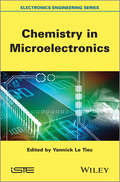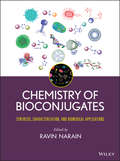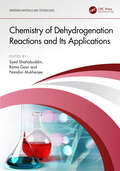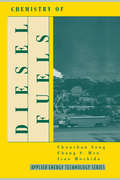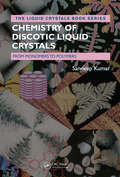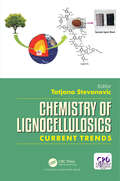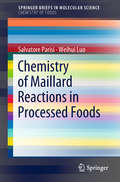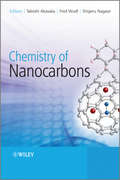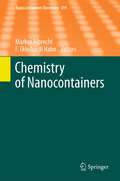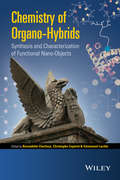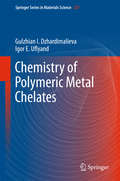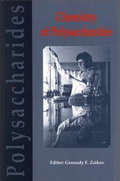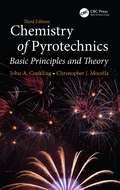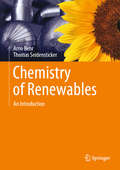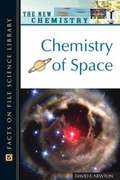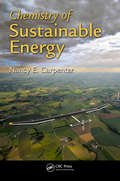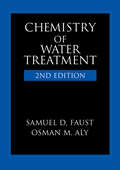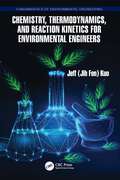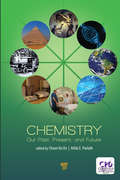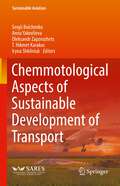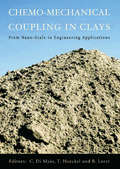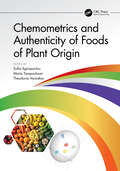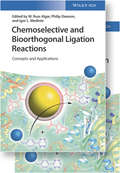- Table View
- List View
Chemistry in Microelectronics
by Yannick Le TiecMicroelectronics is a complex world where many sciences need to collaborate to create nano-objects: we need expertise in electronics, microelectronics, physics, optics and mechanics also crossing into chemistry, electrochemistry, as well as biology, biochemistry and medicine. Chemistry is involved in many fields from materials, chemicals, gases, liquids or salts, the basics of reactions and equilibrium, to the optimized cleaning of surfaces and selective etching of specific layers. In addition, over recent decades, the size of the transistors has been drastically reduced while the functionality of circuits has increased. This book consists of five chapters covering the chemicals and sequences used in processing, from cleaning to etching, the role and impact of their purity, along with the materials used in “Front End Of the Line” which corresponds to the heart and performance of individual transistors, then moving on to the “Back End Of the Line” which is related to the interconnection of all the transistors. Finally, the need for specific functionalization also requires key knowledge on surface treatments and chemical management to allow new applications. Contents 1. Chemistry in the “Front End of the Line” (FEOL): Deposits, Gate Stacks, Epitaxy and Contacts, François Martin, Jean-Michel Hartmann, Véronique Carron and Yannick Le Tiec. 2. Chemistry in Interconnects, Vincent Jousseaume, Paul-Henri Haumesser, Carole Pernel, Jeffery Butterbaugh, Sylvain Maîtrejean and Didier Louis. 3. The Chemistry of Wet Surface Preparation: Cleaning, Etching and Drying, Yannick Le Tiec and Martin Knotter. 4. The Use and Management of Chemical Fluids in Microelectronics, Christiane Gottschalk, Kevin Mclaughlin, Julie Cren, Catherine Peyne and Patrick Valenti. 5. Surface Functionalization for Micro- and Nanosystems: Application to Biosensors, Antoine Hoang, Gilles Marchand, Guillaume Nonglaton, Isabelle Texier-Nogues and Francoise Vinet. About the Authors Yannick Le Tiec is a technical expert at CEA-Leti, Minatec since 2002. He is a CEA-Leti assignee at IBM, Albany (NY) to develop the advanced 14 nm CMOS node and the FDSOI technology. He held different technical positions from the advanced 300 mm SOI CMOS pilot line to different assignments within SOITEC for advanced wafer development and later within INES to optimize solar cell ramp-up and yield. He has been part of the ITRS Front End technical working group at ITRS since 2008.
Chemistry of Bioconjugates
by Ravin NarainExplores bioconjugate properties and applications of polymers, dendrimers, lipids, nanoparticles, and nanotubesBioconjugation has enabled breakthroughs across many areas of industry and biomedicine. With its emphasis on synthesis, properties and applications, this book enables readers to understand the connection between chemistry and the biological application of bioconjugated materials. Its detailed descriptions of methods make it possible for researchers to fabricate and take full advantage of bioconjugates for a broad range of applications. Moreover, the book sets the foundation for the development of new applications, including assays, imaging, biosensors, drug delivery, and diagnostics.Chemistry of Bioconjugates features contributions from an international team of leading experts and pioneers in the field. These contributions reflect the authors' firsthand laboratory experience as well as a thorough review of the current literature. The book's six sections examine:General methods of bioconjugationPolymer bioconjugatesOrganic nanoparticle-based bioconjugatesInorganic nanomaterial bioconjugates, including metals and metal oxidesCell-based, hydrogel/microgel, and glyco-bioconjugatesCharacterization, physico-(bio)chemical properties, and applications of bioconjugatesThis comprehensive exploration of bioconjugates includes discussions of polymers, dendrimers, lipids, nanoparticles, and nanotubes. References at the end of each chapter serve as a gateway to the most important original research findings and reviews in the field.By drawing together and analyzing all the latest chemical methods and research findings on the physico-chemical and biochemical properties of bioconjugates, Chemistry of Bioconjugates sheds new light on the significance and potential of bioconjugation. The book is recommended for organic and polymer chemists, biochemists, biomaterial scientists, carbohydrate chemists, biophysicists, bioengineers, and drug and gene delivery scientists.
Chemistry of Dehydrogenation Reactions and Its Applications (Emerging Materials and Technologies)
by Nandini Mukherjee Syed Shahabuddin Rama GaurThe present book focuses on advancement in the application of heterogeneous catalytic materials for the dehydrogenative synthesis of valuable organic compounds from substrates such as alcohols and simple aliphatic compounds. Several heterogeneous transition metals-based catalytic materials are explored for the synthesis of valuable chemicals for industrial applications. The book provides insight into the application of state-of-the-art technology for energy utilization and clean chemical synthesis. Features: Offers a wide overview of dehydrogenation catalytic chemistry catalyzed by transition metals and their compounds. Helps design novel and more benign and uncomplicated protocols for the synthesis of valuable chemicals from readily available raw materials. Provides deeper insight into the aspect of dehydrogenation reactions for clean chemical synthesis via a cascade process. Summarizes new mechanistic details of dehydrogenation reactions, experimental side development and applications of dehydrogenation techniques. Explores alternative solutions for the assimilation and transportation of clean energy in the form of hydrogen energy utilization. This book is aimed at graduate students and researchers in chemical engineering, chemistry, catalysis, organic synthesis, pharmaceutical chemistry and petrochemistry.
Chemistry of Diesel Fuels
by Chunsham SongThis edited work covers diesel fuel chemistry in a systematic fashion from initial fuel production to the tail pipe exhaust. The chapters are written by leading experts in the research areas of analytical characterization of diesel fuel, fuel production and refining, catalysis in fuel processing, pollution minimization and control, and diesel fuel additives.
Chemistry of Discotic Liquid Crystals: From Monomers to Polymers (Liquid Crystals Book Series)
by Sandeep KumarThe self-contained properties of discotic liquid crystals (DLCs) render them powerful functional materials for many semiconducting device applications and models for energy and charge migration in self-organized dynamic functional soft materials. The past three decades have seen tremendous interest in this area, fueled primarily by the possibility
Chemistry of Fossil Fuels and Biofuels
by Harold SchobertFocusing on today's major fuel resources – ethanol, biodiesel, wood, natural gas, petroleum products and coal – this book discusses the formation, composition and properties of the fuels, and the ways in which they are processed for commercial use. It examines the origin of fuels through natural processes such as photosynthesis and the geological transformation of ancient plant material; the relationships between their composition, molecular structures and physical properties; and the various processes by which they are converted or refined into the fuel products appearing on today's market. Fundamental chemical aspects such as catalysis and the behaviour of reactive intermediates are presented and global warming and anthropogenic carbon dioxide emissions are also discussed. The book is ideal for graduate students in energy engineering, chemical engineering, mechanical engineering and chemistry, as well as professional scientists and engineers.
Chemistry of Hazardous Materials
by Eugene MeyerChemistry of Hazardous Materials, Sixth Edition, covers basic chemistry for emergency responders, guiding students who are often non-science majors through the process of understanding the chemical properties that make materials hazardous. This text covers many essential hazardous materials topics, such as the Globally Harmonized System of Classification and Labeling of Chemical Substances (GHS); terrorist threats relative to biological, chemical, and radioactive agents; and the latest best practices for the handling and storage of hazardous materials. This new edition continues to emphasize the hazardous materials regulations established by the OSHA, the U.S. D.O.T., and the EPA.
Chemistry of Lignocellulosics: Current Trends
by Tatjana StevanovicThis book presents the chemical properties of lignocellulosic fibers, knowledge of which is essential for innovation and sustainable development of their transformation. Thermochemical transformation of wood and other lignocellulosics is presented to highlight its volatile, liquid and solid products and their novel applications. Forest biorefinery is described to emphasize the new products from lignocellulosic constituents, both structural (cellulose, hemicelluloses and lignins) and those extraneous to cell walls-extractives. New developments in cellulose technology related to nanocellulose are discussed in relation to new applications. Industrial lignins are presented in detail, both in terms of extraction procedures from spent liquors and structural characterization of the isolated lignins. Application of lignocellulosic biopolymers in new composite materials, or in biomaterials for medicinal purposes, and in solid wood preservation, are described. The example of an industrial biorefinery installed in southwestern France more than 40 years ago is presented.
Chemistry of Maillard Reactions in Processed Foods (Springerbriefs In Molecular Science)
by Salvatore Parisi Weihui LuoThis SpringerBrief explains the importance of Maillard reactions in food processing. It underlines that the term “Maillard reaction” actually does not describe one single chemical reaction, but an entire class of chemical reactions, which lead to browning, with a strong impact on visual appearance, odor, and flavor. It emphasizes that the Maillard reactions are still not fully characterized, despite extensive historical studies. While under the right conditions Maillard reactions have many favorable effects (e.g. formation of antioxidants), the Brief discusses that there are also conditions where Maillard reactions can result in toxic or mutagenic reactions. Hence, it emphasizes that the reaction should be viewed as a complex network of various sub-reactions, with a plethora of concomitant reaction mechanisms and kinetics. This Brief thus makes a step toward a holistic evaluation of the complexity of the Maillard reaction scheme, with the aim of making better and more targeted use in food processing.
Chemistry of Nanocarbons
by Fred Wudl Shigeru Nagase Takeshi AkasakaDuring the last decade, fullerenes and carbon nanotubes have attracted special interest as new nanocarbons with novel properties. Because of their hollow caged structure, they can be used as containers for atoms and molecules, and nanotubes can be used as miniature test-tubes.Chemistry of Nanocarbons presents the most up-to-date research on chemical aspects of nanometer-sized forms of carbon, with emphasis on fullerenes, nanotubes and nanohorns. All modern chemical aspects are mentioned, including noncovalent interactions, supramolecular assembly, dendrimers, nanocomposites, chirality, nanodevices, host-guest interactions, endohedral fullerenes, magnetic resonance imaging, nanodiamond particles and graphene. The book covers experimental and theoretical aspects of nanocarbons, as well as their uses and potential applications, ranging from molecular electronics to biology and medicine.
Chemistry of Nanocontainers (Topics in Current Chemistry #319)
by Markus Albrecht F. Ekkehardt HahnMolecular Cages and Capsules with Functionalized Inner Surfaces, by Stefan Kubik. Drug Delivery by Water-Soluble Organ metallic Cages, by Bruno Therrien. Reversibly Expanded Encapsulation Complexes, by Dariush Ajami und Julius Rebek. Container Molecules Based on Imine Type Ligands, by A. Carina Schulze und Iris M. Oppel. Molecular Capsules Derived from Resorcin[4]arenes by Metal-Coordination, by Tobias Schröder, Satya Narayan Sahu und Jochen Mattay. Coronates, Spherical Containers, Bowl-Shaped Surfaces, Porous 1D-, 2D-, 3D-Metallo-Coordination Polymers, and Metallodendrimers, by Rolf W. Saalfrank und Andreas Scheurer.
Chemistry of Organo-hybrids
by Christophe Coperet Bernadette Charleux Emmanuel LacoteThis book provides readers with a one-stop entry into thechemistry of varied hybrids and applications, from a molecularsynthetic standpoint* Describes introduction and effect of organicstructures on specific support components (carbon-based materials,proteins, metals, and polymers).* Chapters cover hot topics including nanodiamonds,nanocrystals, metal-organic frameworks, peptide bioconjugates, andchemoselective protein modification* Describes analytical techniques, with pros and cons,to validate synthetic strategies* Edited by internationally-recognized chemists fromdifferent backgrounds (synthetic polymer chemistry, inorganicsurfaces and particles, and synthetic organic chemistry) to pulltogether diverse perspectives and approaches
Chemistry of Polymeric Metal Chelates
by Gulzhian I. Dzhardimalieva Igor E. UflyandThis book deals with the chemistry of polymeric metal chelates. The main results and the production and chemical structure of polymers with chelate units as well as the specificity of metal complex binding of different structure are presented here. This book also reveals the transformations which components undergo in the course of chelation. Special attention is paid not only to synthetic but also to natural (including living) systems. The usage of polymeric metal chelates and their development are examined. The related research was performed for chelates with chain structure. This book is useful to researchers being active in synthesis and design of macromolecular metal chelates
Chemistry of Polysaccharides
by Gennady E. ZaikovThis monograph summarizes scientific achievements in the field of polysaccharide chemistry performed in the last decade. The book is intended for wide range of readers: students, post graduates, engineers and scientists engaged in polymer chemistry, organic and physical chemistry.
Chemistry of Pyrotechnics: Basic Principles and Theory, Third Edition
by Chris Mocella John A. ConklingThis book provides chemists with technical insight on pyrotechnics and explosives. It emphasizes basic chemical principles and practical, hands-on knowledge in the preparation of energetic materials. It examines the interactions between and adaptations of pyrotechnics to changing technology in areas such as obscuration science and low-signature flame emission. The updated third edition discusses chemical and pyrotechnic principles, components of high-energy materials, elements of ignition, propagation, and sensitivity. It offers heat compositions, including ignition mixes, delays, thermites, and propellants and investigates the production of smoke and sound as well as light and color.
Chemistry of Renewables: An Introduction
by Arno Behr Thomas SeidenstickerThis textbook introduces the industrial production and processing of natural resources. It is divided into six major topics (fats and oils, carbohydrates, lignin, terpenoids, other natural products, biorefinery), which are divided into a total of 20 chapters.Each chapter is self-contained and therefore a compact learning unit, which can be worked on by students in self-study or presented by lecturers. Clear illustrations, flow diagrams, apparatus drawings and photos facilitate the understanding of the subject matter. All chapters end with a succinct summary, the "Take Home Messages". Each chapter is supplemented by ten short test questions, which can be solved quickly after working through the chapter; the answers are at the end of the book. All chapters contain bibliographical references that focus on essential textbooks and reference works. As a prior knowledge, only basic knowledge of chemistry is required.
Chemistry of Space
by David E. NewtonChemistry of Space provides an overview of the latest information about the solar system, comets, and meteors, and other features of the universe made available as a result of space exploration and research in astrochemistry. The volume is an impressive account of our universe, the events through which it was created, the changes that have taken place during its evolution, and its present composition.
Chemistry of Sustainable Energy
by Nancy E. CarpenterUnderstanding the chemistry underlying sustainable energy is central to any long-term solution to meeting our future energy needs. Chemistry of Sustainable Energy presents chemistry through the lens of several sustainable energy options, demonstrating the breadth and depth of research being carried out to address issues of sustainability and the gl
Chemistry of Water Treatment
by Samuel D. Faust Osman M. AlyThis second edition demonstrates how chemistry influences the design of water treatment plants and how it should influence the design.Historically, water treatment plants have been designed from hydraulic considerations with little regard to chemical aspects. The many chemical reactions used for removal of pollutants from water simply cannot be forced to occur within current designs. This book re-examines this traditional approach in light of today's water quality and treatment.Will current water treatment processes be sufficient to meet future demands or will new processes have to be devised? Chemistry of Water Treatment assesses the chemical and physical efficacies of current processes to meet the demands of the Safe Drinking water Act, providing expert information to persons responsible for the production of potable water into the next century.
Chemistry, Thermodynamics, and Reaction Kinetics for Environmental Engineers (Fundamentals of Environmental Engineering)
by Jeff KuoThis book aims to be the preeminent university chemistry textbook for environmental engineers. It provides undergraduate and graduate environmental engineering students with basic concepts and practical knowledge about chemistry that they would need in their professional careers. It focuses on the fundamental concepts of chemistry and its practical applications (e.g., understanding fate and transport of chemicals/pollutants in the environmental as well as the chemical/physicochemical processes applied in environmental engineering industry). This book also serves as a valuable resource for entry-level professionals to solidify their fundamental knowledge in environmental engineering chemistry. This book Presents the fundamentals of chemistry with focus on the needs of environmental engineers. Explains how an understanding of chemistry allows readers a better understanding of the fate and transport of chemicals in the environment as well as various treatment processes. Examines the fundamentals of chemical reaction equilibrium from learning the basics of thermodynamics. Presents the basic types and designs of reactors as well as reaction kinetics.
Chemistry: Our Past, Present, and Future
by Attila E. PavlathThis book discusses the vital role of chemistry in everyday life. It encourages readers to understand how the knowledge of chemistry is important for the development of society and a better future. The text is organized into three parts. Part 1 covers the historical aspects of chemistry and discusses how countless discoveries since the beginning of life on earth have benefited human beings. Part 2 focuses on modern life and describes chemistry’s contribution to the developments in the fields of food and agriculture, energy, transportation, medicine, and communications. Part 3 emphasizes the role of chemists and educators in making the layperson aware of the benefits of chemistry without having them to go through its complexities. Written in an easy-to-understand manner and supplemented by ample number of figures and tables, the book will cater to a broad readership ranging from general readers to experts.
Chemmotological Aspects of Sustainable Development of Transport (Sustainable Aviation)
by T. Hikmet Karakoc Sergii Boichenko Anna Yakovlieva Oleksandr Zaporozhets Iryna ShkilniukThis book looks at chemmotological solutions to important questions surrounding sustainability and environmental safety of transport — both key priorities within the global strategy of sustainable development. Bringing together expanded versions of selected papers presented at the 8th International Scientific-Technical Conference: Problems of Chemmotology – Theory and Practice of Rational Use of Conventional and Alternative Fuels and Lubricants, contributors present solutions to problematic questions, including choosing feedstock and technologies of its processing for manufacturing alternative fuels, development and implementation of measures for improving environmental safety of transport, minimizing exhaust gases emission from transport, introducing new solution or improvements in systems of fuels supply and infrastructure, and changes in legislative and regulatory base for fuels and lubricants use. This collection will be an invaluable reference for researchers, professionals, and students involved in alternative aviation fuels, transport engineering, sustainable transport development, and fuels and lubricants.
Chemo-Mechanical Coupling in Clays: Proceedings of the Workshop, Maratea, 38-30 June 2001
by C. Di Maio T. Hueckel B. LoretClay behaviour is affected by coupled mechanical and chemical processes occurring in them at various scales. The peculiar chemical and electro-chemical properties of clays are the source of many undesired effects. These papers provide insight into the variables controlling clay behaviour.
Chemometrics and Authenticity of Foods of Plant Origin
by Theodoros Varzakas Sofia Agriopoulou Maria TarapoulouziOne of the challenges facing the world is feeding the ever-increasing population, with food security being a growing 21st century problem. This stresses the need for coordinated international systems to prevent and mitigate food fraud in global food supply chains. Food fraud, which is usually financially motivated, has significant consequences including unfair competition, major damage to markets and organizations, loss of consumer confidence, and it raises food safety issues. A shift toward a more plant-based diet can be endorsed to promote sustainability but also to improve public health and minimize animal suffering. The aim of this book is to deal with issues related to authenticity and chemometrics of the most important food products of plant origin, such as cereals, nuts, legumes, table olives and olive oil, coffee, tea, fruits and vegetables, fruit juices, spices, mushrooms, beers and wines, and honey, using state-of-the-art analytical techniques and instrumentation coupled with available chemometric tools.
Chemoselective and Bioorthogonal Ligation Reactions: Concepts and Applications
by Igor L. Medintz Philip Dawson W. Russ AlgarThis timely, one-stop reference is the first on an emerging and interdisciplinary topic. Covering both established and recently developed ligation chemistries, the book is divided into two didactic parts: a section that focuses on the details of bioorthogonal and chemoselective ligation reactions at the level of fundamental organic chemistry, and a section that focuses on applications, particularly in the areas of chemical biology, biomaterials, and bioanalysis, highlighting the capabilities and benefits of the ligation reactions. With chapters authored by outstanding scientists who range from trailblazers in the field to young and emerging leaders, this book on a highly interdisciplinary topic will be of great interest for biochemists, biologists, materials scientists, pharmaceutical chemists, organic chemists, and many others.
